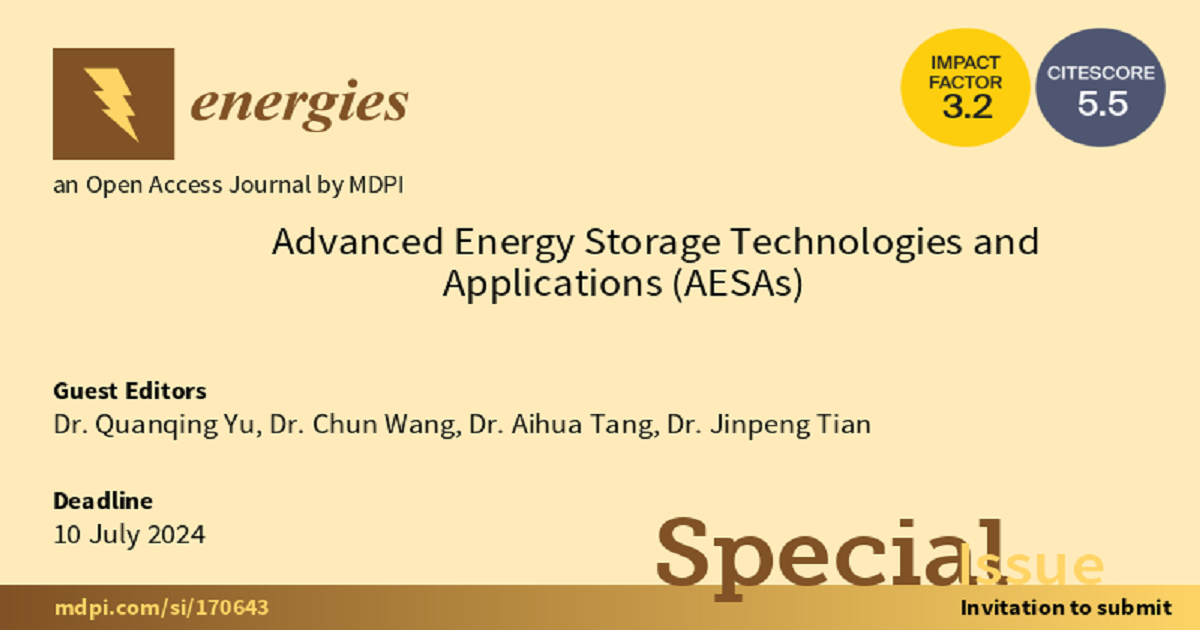Advanced Energy Storage Technologies and Applications (AESAs)
A special issue of Energies (ISSN 1996-1073). This special issue belongs to the section "D: Energy Storage and Application".
Deadline for manuscript submissions: 10 July 2024 | Viewed by 4181

Special Issue Editors
Interests: battery reliability analysis; battery health management; battery state estimation
Special Issues, Collections and Topics in MDPI journals
Interests: multi-power integrated management and optimal control of new energy vehicles; artificial intelligence management and control of advanced energy storage systems; optimized control of intelligent connected vehicles
Special Issues, Collections and Topics in MDPI journals
Interests: battery system modeling; state estimation and life prediction; battery system fault diagnosis and health status estimation under big data
Special Issues, Collections and Topics in MDPI journals
Special Issue Information
Dear Colleagues,
The development of renewable energy (such as wind energy and solar energy) is an effective way to alleviate global environmental pollution and reduce dependence on fossil energy. However, the intermittency of renewable energy has hindered the deployment of large-scale intermittent renewable energy, which, therefore, has necessitated the development of advanced large-scale energy storage technologies. The use of advanced large-scale energy storage can effectively improve the efficiency of energy resource utilization, and increase the use of variable renewable resources and the end-use sector electrification (e.g., the electrification of the transport sector).
This Special Issue primarily aims to provide a platform for presenting the latest research findings on the technology development of large-scale energy storage. We welcome research papers on theoretical, methodological, and empirical studies, as well as review papers that provide a critical overview on the state-of-the-art of technologies. This Special Issue is open to all types of energy (such as thermal energy, mechanical energy, electrical energy, and chemical energy) using different types of systems (such as phase change materials, batteries, supercapacitors, fuel cells, compressed air, etc.) that are applicable to various types of applications (such as heat and power generation, electrical/hybrid transportation, etc.).
Topics of interest of this Special Issue include, but are not limited to, the following:
- Novel energy storage materials and topologies;
- Applications in electrical/hybrid-driven systems and electrical/hybrid vehicles;
- Next-generation energy storage devices, systems, or techniques;
- Large-scale energy storage system modeling, simulation, and optimization (including testing and modelling ageing processes);
- Advanced control systems for energy storage
- Business model for the application and deployment of energy storage;
- Lifecycle analysis, safety, and reliability evaluation of energy storage systems.
Dr. Quanqing Yu
Dr. Chun Wang
Dr. Aihua Tang
Dr. Jinpeng Tian
Guest Editors
Manuscript Submission Information
Manuscripts should be submitted online at www.mdpi.com by registering and logging in to this website. Once you are registered, click here to go to the submission form. Manuscripts can be submitted until the deadline. All submissions that pass pre-check are peer-reviewed. Accepted papers will be published continuously in the journal (as soon as accepted) and will be listed together on the special issue website. Research articles, review articles as well as short communications are invited. For planned papers, a title and short abstract (about 100 words) can be sent to the Editorial Office for announcement on this website.
Submitted manuscripts should not have been published previously, nor be under consideration for publication elsewhere (except conference proceedings papers). All manuscripts are thoroughly refereed through a single-blind peer-review process. A guide for authors and other relevant information for submission of manuscripts is available on the Instructions for Authors page. Energies is an international peer-reviewed open access semimonthly journal published by MDPI.
Please visit the Instructions for Authors page before submitting a manuscript. The Article Processing Charge (APC) for publication in this open access journal is 2600 CHF (Swiss Francs). Submitted papers should be well formatted and use good English. Authors may use MDPI's English editing service prior to publication or during author revisions.








